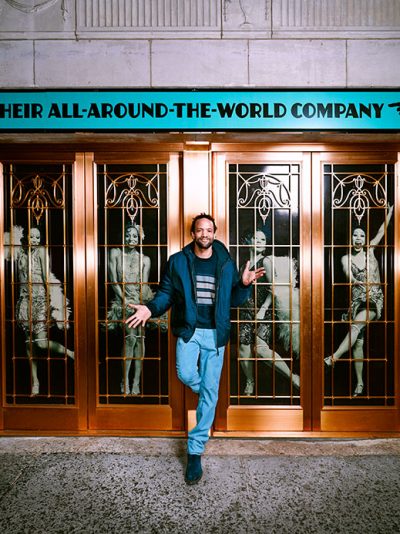
Savion Glover tells mesmerizing stories with his feet. Stories with words come with less fanfare, but he’s telling them quite often.
Especially to New Jersey audiences.
“My role is to be like a host,” says Glover of his new gig as an artistic director at NJPAC. “I talk a little bit about companies that are coming through, and I talk a little bit about myself.” On this March day, the busy Tony-winning dancer and Newark native was talking during a dinner break at the Music Box Theatre in Manhattan, where he was rehearsing the Broadway show Shuffle Along, for which he is choreographer.
Glover, who signed on with NJPAC in January, is the third artistic advisor called upon to help steer what he calls “the PAC.” He’s in distinguished company. The bassist and Montclair resident Christian McBride was recruited first in 2012, and the poet Patricia Smith, of Howell, joined him last year. Their mission is to get people into the theater and to do some local resurrecting of the art that gave each liftoff. So far, so good, says John Schreiber, NJPAC’s CEO and the guy who handpicked all three.
Schreiber introduced Glover as artistic director in February at a performance by Dance Theatre of Harlem. “It was like Jackie Robinson had showed up,” says Schreiber. “He’s a hero.”
Once Glover, 42, has had a chance to find his footing as artistic director—in late winter and early spring he was still working 12-hour days on Shuffle Along, uprooting himself from his Warren County home to live temporarily in Manhattan—he’s likely to become an even bigger hero. In addition to presenting and talking to fans at dance shows, like this month’s NJPAC performances by the Alvin Ailey American Dance Theater, Glover plans to offer dance workshops to local public school kids that will culminate in small performances for friends and family. No date has been set for the initial sessions, but Glover is already sketching out the details.
“He’s calling it Club Bring Time Back, and he’ll offer it a couple of days a week,” says Schreiber. “It’s an opportunity for kids to practice tap in a fun, non-threatening environment.” It’s also an opportunity to keep locals thinking about dance.
“There’s one audience that’s hard to get, and it’s an audience that feels disenfranchised by the arts in general,” Schreiber says. “The citizens of greater Newark are struggling in an economically depressed part of the world. A lot of the constituency is working two jobs, three jobs. Getting to the theater is not at the top of their minds.” Glover, he says, is well suited to remind them why live performances are worth the trouble.
“Savion relates across all audiences, to everybody. By having an association with us, I think what he’s saying is, ‘Take a chance and come out,’” Schreiber says. “He’s making people take notice.”
It’s something he’s been doing most of his life. Glover, winner of the 1996 Tony for his fierce footwork in Bring in Da Noise, Bring in Da Funk, started dancing on Broadway at age 10. Becoming a Newark notable is in his DNA: His great-grandfather was a shortstop in baseball’s Negro Leagues who went on to manage 11 teams, including the Newark Eagles. His grandmother directed a young Whitney Houston in the gospel choir as minister of music at New Hope Baptist Church. Noise/Funk made him a dance superstar, but Glover had already won fans as a regular on Sesame Street. He has also starred in Spike Lee’s 2000 film Bamboozled and choreographed the role of Mumble in the animated Happy Feet and Happy Feet 2.
Despite his new commitments, Glover has no plans to hang up his size-12 dancing shoes.
“I’ve still got it,” he says during his break from the Shuffle Along rehearsal. His dreadlocks are tied in a neat bun, and he eats from a plastic plate of just salad and fresh fruit. His bites are tiny; he exactingly cuts each green bean in half before lifting it to his mouth. “I’m choreographing now, and I might be directing next, but I’m going to continue to dance. I’ve still got a lot to say.”
NJPAC is counting on it. They’ve already got the world premiere of his new show, Chronology of a HooFer, on the calendar for September 23. The autobiographical work—described by Glover’s management as “a reverie of his forefathers in tap, and how it all happened for him”—should have plenty of pull with Newark audiences.
In his initial meetings with NJPAC, “it was just me allowing them to know how I think they can add to the diversity of people who come to see performances,” Glover says. He refers to his role as that of dance ambassador. “Through the evenings I’ll be presenting, I think we might be able to reach a demographic that normally wouldn’t go see Fiddler on the Roof. No disrespect to Fiddler on the Roof.”
A broad demographic is likely to be enticed by Shuffle Along, a revival of an African-American revue with music and lyrics by Noble Sissle and Eubie Blake that premiered on Broadway in 1921. The new adaptation’s director and book writer, George C. Wolfe, directed a teenage Glover 24 years ago in Jelly’s Last Jam. (Glover played the young Jelly Roll Morton.) The cast of the revival includes superstars Audra McDonald and Brian Stokes Mitchell.
Glover can relate to the roots of his art, and feels kinship with fellow artists who display a healthy respect for their forebears. Just ask anyone familiar with the HooFeRzClub, the tap academy he founded in 2009 on Brunswick Street—on what Glover calls “one of the most notorious blocks in Newark.”
Hometown pride and the urge to make a gritty address less so were not on his mind when he launched the school. “I hadn’t thought about owning a school in Newark. That wasn’t part of my plan,” he says. “What happened was, a friend of mine was driving by. He called me up and said, ‘Hey, there’s this building for sale.’ It had been abandoned for a year or two, but it was the location of the first Newark School of the Arts, where I went to school from when I was a toddler on up.” (The School of the Arts, where Glover took his first dance class, has since moved elsewhere in Newark.) “So I went and looked at it, and I purchased it. That’s when I got the idea to have a school and my office and a small performance space there.”
The heart of the enterprise, Glover says, is the school. It’s not a traditional one where little girls in pastel tutus supplement their ballet lessons with 45-minute tap and jazz sessions. Glover has no interest in dabblers.
Surprisingly, neither does he have much interest in producing the next wave of great tap dancers.
“What we’re looking for at my school is intellectuals,” he says. “People who want to talk about the art and be knowledgeable about it. People who want to know the history. Not everybody needs to be performing. I want my students to understand and be familiar with the people I had the privilege of learning from,” including the legends Gregory Hines and Jimmy Slyde. To that end, “we don’t start any physical activity at the school until after at least six months of learning,” he says.
By then, he hopes, tap will start to seem like a language to enrollees, who come from all over the world to study under Glover and his handful of hand-picked instructors. One girl made a pilgrimage from Taiwan. “I think she caught a plane to California, then she hitchhiked the rest of the way,” he says. He appreciates the dedication—and expects it. “There has to be a real emotional connection. For me the importance in learning about the dance is using it as a voice,” he says. “It’s not about a step, it’s about a way to express oneself. I don’t deal in terminology, I deal with expressions: colors, shapes, tones, characteristics.”
Schreiber, who has been watching Glover dance since the 1980s, gets it.
“He’s kind of like the Duke Ellington of tap,” says Schreiber, a longtime jazz producer and creator of NJPAC’s TD James Moody Jazz Festival. “He’s always workshopping, writing, trying to figure out the vocabulary of dance to tell a story. There’s nothing predictable about his work, which is like Ellington. There’s a New Yorker writer who called jazz ‘the sound of surprise.’ That’s what you get with Savion.”
NJPAC, Schreiber admits, should have invited Glover to play a bigger role at the venue years ago, adding, “I guess we just weren’t hip enough to activate him till now.”
From Glover’s point of view, NJPAC and Schreiber needn’t worry about a lack of hipness.
“People in positions like his didn’t used to be so cool,” says Glover. “I mean, you’d go into establishments, and it wasn’t like it is with him, where the top cat is so hip. He’s, like, a real cool dude.”
And that makes Glover even more jazzed to be dance ambassador: “I’m proud to lend my name to the PAC.”
Correspondent Tammy La Gorce would love to learn to tap dance—but these days she taps only at her laptop.
